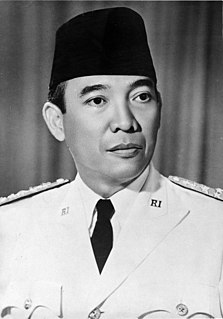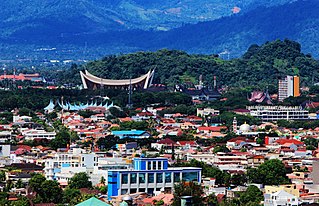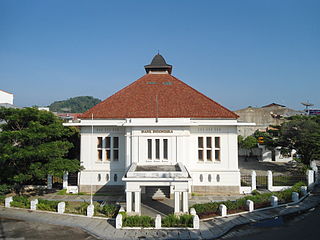The history of Indonesia has been shaped by its geographic position, its natural resources, a series of human migrations and contacts, wars and conquests, as well as by trade, economics and politics. Indonesia is an archipelagic country of 17,000 to 18,000 islands stretching along the equator in South East Asia. The country's strategic sea-lane position fostered inter-island and international trade; trade has since fundamentally shaped Indonesian history. The area of Indonesia is populated by peoples of various migrations, creating a diversity of cultures, ethnicities, and languages. The archipelago's landforms and climate significantly influenced agriculture and trade, and the formation of states. The boundaries of the state of Indonesia represent the 20th century borders of the Dutch East Indies.

Netherlands New Guinea refers to the Papua region of Indonesia while it was an overseas territory of the Kingdom of the Netherlands from 1949 to 1962. Until 1949 it was a part of the Dutch East Indies. It was commonly known as Dutch New Guinea. It contained what are now Indonesia's two easternmost provinces, Papua and West Papua, which were administered as a single province prior to 2003 under the name Irian Jaya.

Sukarno was the first President of Indonesia, serving from 1945 to 1967.

Batavia, also called Betawi in the city's local Malay vernacular, was the capital of the Dutch East Indies. The area corresponds to present-day Jakarta. Batavia can refer to the city proper, as well as its suburbs and hinterland, the Ommelanden, which included the much larger area of the Residency of Batavia in today's Indonesian provinces of DKI Jakarta, Banten and West Java. In Betawi Malay, the area constituting the former Residency of Batavia is called Tanah Betawi.

Colonial India was the part of the Indian subcontinent which was under the jurisdiction of European colonial powers, during the Age of Discovery. European power was exerted both by conquest and trade, especially in spices. The search for the wealth and prosperity of India led to the colonization of the Americas by Christopher Columbus in 1492. Only a few years later, near the end of the 15th century, Portuguese sailor Vasco da Gama became the first European to re-establish direct trade links with India since Roman times by being the first to arrive by circumnavigating Africa. Having arrived in Calicut, which by then was one of the major trading ports of the eastern world, he obtained permission to trade in the city from Saamoothiri Rajah.

Mohammad Hatta was Indonesia's first vice president, later also serving as the country's prime minister. Known as "The Proclamator", he and a number of Indonesians, including the first president of Indonesia, Sukarno, fought for the independence of Indonesia from the Dutch. Hatta was born in Fort De Kock, West Sumatra, Dutch East Indies. After his early education, he studied in Dutch schools in the Dutch East Indies and studied in the Netherlands from 1921 until 1932.

Padang is the capital of the province of West Sumatra in Indonesia. With an area of 695 square kilometres (268 sq mi) and a population of 914,970 in 2016, it is the 10th-most populated urban centres in Indonesia, the most populated city on Sumatra's western coast, and fourth-most populated city on Sumatra.

The Dutch colonial empire comprised the overseas territories and trading posts controlled and administered by Dutch chartered companies and subsequently by the Dutch Republic (1581–1795), and by the modern Kingdom of the Netherlands after 1815. It was initially a trade-based system which derived most of its influence from merchant enterprise and from Dutch control of international maritime shipping routes through strategically placed outposts, rather than from expansive territorial ventures. With a few notable exceptions, the majority of the Dutch colonial empire's overseas holdings consisted of coastal forts, factories, and port settlements with varying degrees of incorporation of their hinterlands and surrounding regions. Dutch chartered companies often dictated that their possessions be kept as confined as possible in order to avoid unnecessary expense, and while some such as the Dutch Cape Colony and Dutch East Indies expanded anyway, others remained undeveloped, isolated trading centres dependent on an indigenous host-nation. This reflected the primary purpose of the Dutch colonial empire: commercial exchange as opposed to sovereignty over homogeneous landmasses.
Herman Thomas Karsten was a Dutch engineer who gave major contributions to architecture and town planning in Indonesia during Dutch colonial rule. Most significantly he integrated the practice of colonial urban environment with native elements; a radical approach to spatial planning for Indonesia at the time. He introduced a neighborhood plan for all ethnic groups in Semarang, built public markets in Yogyakarta and Surakarta, and a city square in the capital Batavia. Between 1915 and 1941 he was given responsibility for planning 12 out of 19 municipalities in Java, 3 out of 9 towns in Sumatra and a town in Kalimantan. He received official recognition from both the government through his appointment to the colony's major Town Planning Committee and by the academic community with his appointment to the position of Lecturer for Town Planning at the School of Engineering at Bandung. He died in an internment camp near Bandung in 1945 during the Japanese occupation of Indonesia.

The Dutch–Indonesian Round Table Conference was held in The Hague from 23 August to 2 November 1949, between representatives of the Netherlands, the Republic of Indonesia and the BFO representing various states the Dutch had created in the Indonesian archipelago. Prior to this conference, three other high-level meetings between the Netherlands and Indonesia took place; the Linggadjati Agreement (1947), the Renville Agreement (1948), and the Roem-van Roijen Agreement (1949). The conference ended with the Netherlands agreeing to transfer sovereignty to the United States of Indonesia.

Jakarta is Indonesia's capital and largest city. Located on an estuary of the Ciliwung River, on the northwestern part of Java, the area has long sustained human settlement. Historical evidence from Jakarta dates back to the 4th century CE, when it was a Hindu settlement and port. The city has been sequentially claimed by the Indianized kingdom of Tarumanegara, the Hindu Kingdom of Sunda, the Muslim Sultanate of Banten, and by Dutch, Japanese and Indonesian administrations. The Dutch East Indies built up the area before it was taken during World War II by the Empire of Japan and finally became independent as part of Indonesia.

The Dutch East Indies was a Dutch colony consisting of what is now Indonesia. It was formed from the nationalised colonies of the Dutch East India Company, which came under the administration of the Dutch government in 1800.

Dutch colonial architecture in Indonesia were built across the archipelago that once was known as Dutch East Indies. Most of the better and permanent colonial era structures were located in Java and Sumatra, which economically were considered more important during the Dutch imperial period. As a result, there are more surviving colonial buildings in the two island. Plenty of old VOC era forts and warehouses are scattered throughout the archipelago, particularly around Maluku Islands and Sulawesi. There are three Dutch colonial architectural styles:

The Republic of the United States of Indonesia, abbreviated as RUSI, was a federal state to which the Netherlands formally transferred sovereignty of the Dutch East Indies on 27 December 1949 following the Dutch-Indonesian Round Table Conference. This transfer ended the four-year conflict between Indonesian nationalists and the Netherlands that was fought over for control of Indonesia. It lasted less than a year, before being replaced by the unitary Republic of Indonesia.
The military history of Indonesia includes the military history of the modern nation of Republic of Indonesia, as well as the military history of the states which preceded and formed it. It encompassed a kaleidoscope of conflicts spanning over a millennia. The ancient and medieval part of it began as tribal warfare began among indigenous populations, and escalated as kingdoms emerged. The modern part is defined by foreign colonial occupations, battles for independence through guerrilla warfare during Indonesian National Revolution, regional conquests and disputes with neighbouring countries, as well as battles between the Republic and separatist factions. Since the formation of the Republic, the military has played significant role in state affairs. However, in Post-Suharto era, the Indonesian military has retreated from politics, yet it still possesses some influences.
French and British interregnum in the Dutch East Indies were a relatively short period of French and followed by British interregnum on the Dutch East Indies that took place between 1806 and 1815. The French ruled between 1806 and 1811. The British took over for 1811 to 1815, and transferred its control back to the Dutch in 1815.

The Kingdom of Bali was a series of Hindu-Buddhist kingdoms that once ruled some parts of the volcanic island of Bali, in Lesser Sunda Islands, Indonesia. With a history of native Balinese kingship spanning from the early 10th to early 20th centuries, Balinese kingdoms demonstrated sophisticated Balinese court culture where native elements of spirit and ancestral reverence combined with Hindu influences – adopted from India through ancient Java intermediary – flourished, enriched and shaped the Balinese culture.

The Kingdom of Larantuka was a kingdom in present-day East Nusa Tenggara, Indonesia. It was the one of the few, if not the only, indigenous Roman Catholic polities in the territory of modern Indonesia. Acting as a tributary state of the Portuguese Crown, the Raja (King) of Larantuka controlled holdings on the islands of Flores, Solor, Adonara and Lembata. It was later purchased by Dutch East Indies from the Portuguese, prior to its annexation in 1904.

The archaeology of Indonesia is the study of the archaeology of the archipelagic realm that today forms the nation of Indonesia, stretching from prehistory through almost two millennia of documented history. The ancient Indonesian archipelago was a geographical maritime bridge between the political and cultural centers of Ancient India and Imperial China, and is notable as a part of ancient Maritime Silk Road.

The Old Bank Indonesia Building Padang, is a former bank building located in Padang, Indonesia. The building was built on March 31, 1921 as the Padang branch office of De Javasche Bank before it was taken over by Bank Indonesia on July 1, 1953.




















